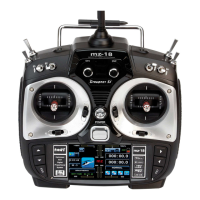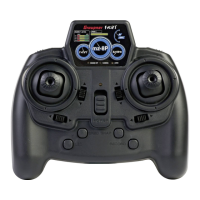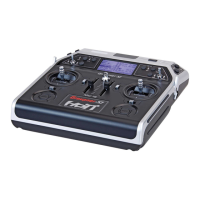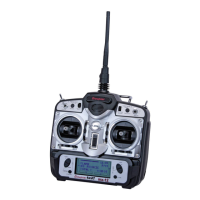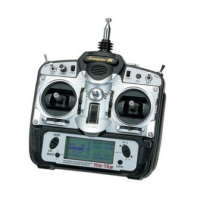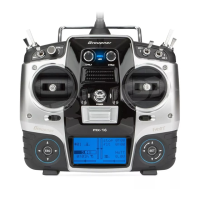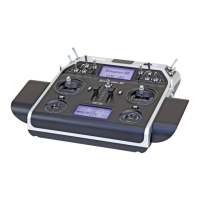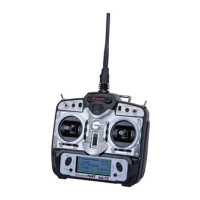full deflection is allowed when the stick is moved to
its limit.
Conversely, the effect of the control around center po-
sition increases for values less than 0% and decreas-
es in the direction of full deflection. The progression
can be set from -100% to +100%; 0% corresponds to
the normal linear control characteristic.
For the most common rotary servos, the rudder con-
trol is nonlinear since the rudder deflection from the
servo linkage becomes increasingly smaller as the an-
gle of rotation of the connecting pulley or cantilever
increases. When EXP values are greater than 0%, this
effect can be counteracted so that the angle of rota-
tion increases disproportionately as the control stick
deflection increases.
The EXP setting always acts directly on the corre-
sponding control function independent of whether
it affects the individual servo or several servos by
means of complex mixing and coupling functions.
The D/R and EXP functions can be switched together
by a single control if the control has been correspond-
ingly assigned. It is possible to link the dual rate and
EXP functions: this can be advantageous, especially
with fast models.
In the display graphic the green vertical line moves to-
gether with the related control stick to allow a clearer
evaluation of the curve characteristics related to the
control travel.
To change between the display screens of individual
setting options, press the value field in the CH line:
Press
BACK
CH
D/R
EXP
CTL
CH 3
+100%
+100%
NULL
INC
RES
DEC
PHASE 1
000%
000%
SERVO
SYM
OFF
D/R,EXP
BACK
CH
D/R
EXP
CTL
CH 4
+100%
+100%
NULL
INC
RES
DEC
PHASE 1
000%
000%
SERVO
SYM
OFF
D/R,EXP
Phase Depending Dual-Rate/Expo Settings
This submenu allows for different phase-specific val-
ues to be programmed. Phase names are displayed
in green in the upper left side of the screen next to
the BACK button. Standard default naming for the
phases are usually displayed as NORMAL/PHASE
1. (Additional phases will be named numerically, e.g.
Phase 2, Phase 3, etc.) To define multiple phases,
refer to the FUNCTION submenu Phase section (page
120). Each new phase will need to be assigned to a
different switch. To change the phases, activate the
corresponding switch(es).
SYM Button
The SYM function allows a symmetrical, simultane-
ous, field adjustment of both control sides. Turn this
function OFF or ON by pressing the button in the
SYM line.
Press
BACK
CH
D/R
EXP
CTL
AILE
+100%
+100%
NULL
INC
RES
DEC
PHASE 1
000%
000%
SERVO
SYM
ON
D/R,EXP
D/R Function
Setting Symmetrical Dual Rate Values
To change between the different versions, assign a
control, 2- or 3-way switch or logical switch in the
CTL line as described in the Control and Switch As-
signment section (page 26):
BACK
CH
D/R
EXP
CTL
AILE
+100%
+100%
NULL
INC
RES
DEC
PHASE 1
000%
000%
SERVO
SYM
ON
D/R,EXP
SELECT
CLR
NO
LOGIC
125
Function menu | general - DR/Expo
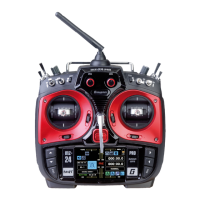
